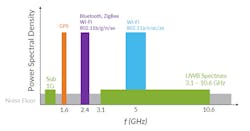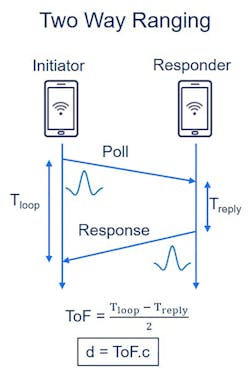UWB Spreads Its Wings for Secure Keyless Access
This article appeared in Microwaves & RF and has been published here with permission.
What you’ll learn:
- Why UWB is fast becoming the technology of choice for keyless vehicle entry.
- The basics of UWB technology.
- How UWB complements Bluetooth Low Energy and other wireless standards.
Ultra-wideband (UWB) was once thought of as a communications technology that never quite made it—until Apple adopted it. UWB is now built into high-end Apple and Samsung phones, with others following, giving the technology not only brand credibility but also the volume that comes with those platforms.
What changed? More than anything else, it’s related to heightened concerns about security for keyless-entry applications, particularly for our vehicles.
Bluetooth, which has commonly been used for keyless entry, is vulnerable to man-in-the-middle (MITM) attacks. Bluetooth key fobs are intended to tell the vehicle to unlock its doors only when the keyless fob is nearby. However, an attacker can use a relay box to boost the weak Bluetooth signal coming from your key fob inside the house while you sleep, which fools the car into thinking the fob is close by.
In contrast, UWB provides much more accurate measurements of the fob’s distance through a process known as “ranging,” down to just a few centimeters—as compared to a few meters for Bluetooth, Wi-Fi, and other technologies. In addition, it has strong security by dint of its physical layer (PHY), making it immune to those MITM attacks that have plagued Bluetooth fobs.
UWB Fundamentals
UWB debuted about 15 years ago as part of the IEEE 802.15.4a standard, but it didn’t find great success in the market. Due to its accurate ranging and strong security, UWB has been experiencing explosive growth recently, with ABI Research forecasting annual shipments of nearly 1 billion devices by 2025.
The latest specification is 802.15.4z. Its use cases are being developed by popular industry groups, namely the FiRa Consortium and the Car Connectivity Consortium (CCC), with CCC focusing mainly on Secure Digital keys and FiRa addressing more general, secured fine-ranging and positioning applications.
Unlike most radio standards, which operate over a relatively narrow band, UWB uses around 500-MHz bandwidth per channel. This can be between 3.1 and 10.6 GHz, although typically UWB operates between 6 and 8.5 GHz. It utilizes only very-low-power signals, which means its transmissions are under the noise floor from the point of view of Wi-Fi, Bluetooth, and other standards (Fig. 1). UWB can therefore operate as an unlicensed service, without disrupting other communications, to provide low-latency data transfer from 110 kb/s up to 31.2 Mb/s.
Accurate ranging is achieved using short, 2-ns pulses. Measuring the time of flight (ToF), as shown in Figure 2, provides an estimate of the range between the initiator and responder devices. If multiple antennas are used, the angle or direction of the responder also can be estimated by the initiator using angle-of-arrival (AoA) processing.
UWB, Bluetooth, and BLE
UWB and Bluetooth are both short-range wireless standards operating without licenses—which could mean there’s a significant overlap between their target markets. Though that’s true, they do have complementary strengths. While UWB has better real-world ranging accuracy, Bluetooth Low Energy (BLE) consumes less power.
A popular approach is to use both together: BLE provides prolonged low-power use and less accurate ranging. Then, once the user is within a defined distance, BLE hands over seamlessly to UWB for secure, fine-ranging access verification. This combination approach has been adopted by both the FiRa Consortium and CCC.
In the meantime, BLE is working on closing the gap; for example, there’s been work on an improvement to high-accuracy distance measurement (HADM). A race persists between the standards, and they both have backing from the dominant smartphone builders. But because UWB has the benefit of being a first mover in precision ranging, we’ll probably see it around for a long time.
The Digital Key
We’ve looked at how car key fobs can use UWB for convenient access to your vehicle—with proximity to the car opening the door without you having to retrieve the fob from your pocket or bag. UWB also can help take this one step further via the ubiquitous smartphone, removing the need for a physical key or fob. With UWB becoming increasingly common on phones, and Bluetooth everywhere, the technology is there already for many of us.
In addition to the convenience of not needing to carry a separate key or fob, adding “digital-key” capabilities to our phones opens new opportunities. You could authenticate your friends or family as trusted users, giving them access to your car, even if you’re away on vacation. Commercial ventures such as car hire and ride sharing could benefit from remote user authentication, too, creating new services or business models.
More UWB Applications
High-security keyless entry to our cars, homes, and hotel rooms is a critical application, but where else could this technology be useful? Industrial real-time location systems (RTLS) represent one possibility, with UWB’s centimeter accuracy complementing the many other RTLS mechanisms. Indoor navigation is another application—using your phone to get centimeter-level accuracy in the local supermarket is an appealing use case for advertisers as much as for consumers.
Beyond navigation and “find-my-stuff” applications like Apple’s AirTag, the spatial awareness enabled by UWB’s precise ranging also creates new opportunities for users to interact with their devices. Instead of the laborious search-select-pair process of Bluetooth gadgets, imagine being able to simply point your phone at a device to take control of it.
Another use case would be seamless music handover between devices when you’re moving around the house, either for your headphones or for speakers in each room. On top of that, pulse-based UWB technology is gaining interest in gesture/presence radar applications, which is being explored by leading laptop manufacturers.
One other promising application is mobile payments: NXP has already demonstrated a UWB-based mobile payment system with NTT Docomo and Sony. While near-field communications (NFC) is popular for current tap-to-pay methods such as Apple Pay, it has its vulnerabilities and limitations. This may be another reason Apple is so keen on UWB, as it sees payments being one of the services driving its future revenue growth. And you can bet everyone else using phone-based payment will switch in a heartbeat, if and/or when Apple goes UWB for contactless payment.
One of UWB’s unsung strengths is its low latency, which means it could find a natural home in audio applications where latency is critical, such as gaming and VR. It also could be useful for super-high-quality audio streaming, possibly for smart speakers.
Complementary Technologies
As mentioned above, UWB and BLE are starting to intrude into each other’s space, with audio being a typical example. That’s great for end users, as competition will drive innovation and cost savings. But what about for OEMs and product builders?
The safest approach is to plan for UWB and BLE by covering both options. UWB has compelling benefits for some applications, while BLE is well-established and offers key advantages in other areas. It’s no surprise that much of what you’ll hear suggests the two solutions are complementary and should be used together.
For this reason, companies like CEVA, with its RivieraWaves portfolio of IP for Bluetooth and Wi-Fi, have now added support for UWB. This gives customers the flexibility to future-proof their product roadmaps and cover whichever path they decide to take. With multiple wireless technologies available from a single supplier, integration is quicker and easier, thus reducing risk in development as well as time to market.
The RivieraWaves UWB platform consists of a power-optimized hardware PHY along with a flexible, low-latency hardware and software MAC layer. The MAC-layer software can be implemented on a CEVA DSP device when deployed with other connectivity workloads or modes such as direction finding, localization, or radar. Alternatively, it could be used as a standalone UWB MAC on commercial Arm and RISC-V MCUs. A flexible radio interface enables the RivieraWaves UWB platform to be deployed with customers’ own RF technology, or with CEVA partners’ RF solutions.
Conclusion
It’s been around for more than a decade, but UWB is finally finding its feet, with rapid growth driven by secure remote access and other applications. Its ability to accurately determine range to within a few centimeters has made it the technology of choice for keyless car access.
Widespread adoption of UWB by major smartphone vendors, and by Apple, may well be the push that’s needed to make UWB truly mainstream soon. For now, OEMs and product designers can minimize their risk by supporting multiple technologies, such as UWB alongside BLE, so that they can respond quickly to any market shifts or new killer applications. Vendors such as CEVA offer flexible platforms that can provide the versatility needed to make this affordable in practice.
About the Author
Paddy McWilliams
Director of Product Marketing, Connectivity Business Unit, CEVA
Paddy McWilliams is the Director of Product Marketing for CEVA's Connectivity Business Unit. Paddy brings over 30 years of experience in semiconductor wired and wireless communications, with a current focus on Bluetooth and Wi-Fi.


